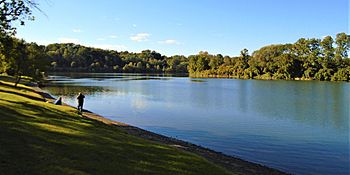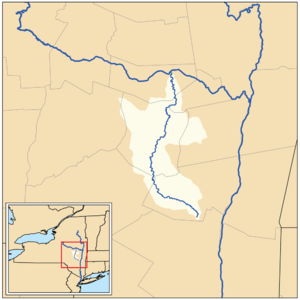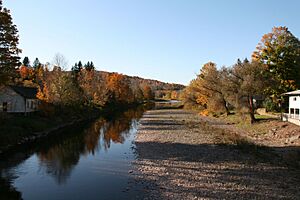Schoharie Creek facts for kids
Quick facts for kids Schoharie Creek |
|
|---|---|

Schoharie Creek flowing into the Mohawk River, from Tribes Hill Park in Amsterdam, New York.
|
|

Map of the Schoharie Creek drainage basin
|
|
| Country | United States |
| State | New York |
| Physical characteristics | |
| River mouth | Mohawk River Fort Hunter, New York, United States 274 ft (84 m) 42°56′28″N 74°17′32″W / 42.94111°N 74.29222°W |
| Length | 93 mi (150 km) |
| Basin features | |
| Basin size | 928 sq mi (2,400 km2) |
| Tributaries |
|
The Schoharie Creek is a river in New York. It flows north for about 93 miles (150 km). Its journey starts at the foot of Indian Head Mountain in the Catskills. The creek then winds through the Schoharie Valley before joining the Mohawk River.
This important creek helps provide water for New York City. It is held back twice by dams. These dams create the Schoharie Reservoir and help power the Blenheim–Gilboa Hydroelectric Power Station.
During the American Revolutionary War, the valley around the creek was a place of conflict. Farms here grew food for the American forces. The Erie Canal once crossed over the creek using a special bridge called an aqueduct.
The Schoharie Creek has also seen two major bridge collapses. In 1987, parts of the New York State Thruway bridge fell into the water. Later, in 2011, the historic Old Blenheim Bridge was destroyed by severe flooding from Hurricane Irene.
Contents
Exploring the Schoharie Creek's Geography
Where Does the Creek Flow?
The Schoharie Creek is part of a larger water system. It flows into the Mohawk River, which then flows into the Hudson River. Think of it like branches on a tree, all leading to the main trunk. The area of land that drains water into the creek is called its watershed.
Many smaller streams flow into the Schoharie Creek. These are called tributaries. Some join from the right side as you look downstream, and others from the left.
- Right Side Tributaries:
- Gooseberry Creek
- Red Kill
- East Kill
- John Chase Brook
- Batavia Kill
- Hunterfield Creek
- Platter Kill
- Keyser Kill
- Little Schoharie Creek
- Stony Brook
- Fox Creek
- Bowman Creek
- Left Side Tributaries:
- Roaring Kill
- Cook Brook
- West Kill
- Little West Kill
- Johnson Hollow Brook
- Bear Kill
- Mine Kill
- West Kill
- Cole Brook
- Panther Creek
- Pleasant Valley Creek
- Line Creek
- Cobleskill Creek
- Cripplebush Creek
- Fly Creek
- Wilsey Creek
- Irish Creek
Understanding the Creek's Water
How Clean is the Water?
The New York State Department of Environmental Conservation (DEC) checks the water quality of the Schoharie Creek. Some parts of the creek are rated "Class C." This means the water is best for fishing, but you can also swim and play in it.
The amount of water flowing in the lower part of the creek changes a lot. This is because of the Schoharie Reservoir dam. When the dam holds back water, especially in summer, the creek's water gets warmer. This can be tough for fish. Also, the creek flows through farms, which can add dirt and soil to the water. This makes the water cloudy, especially when it rains a lot.
Even with these challenges, tests in 2001 showed that the water quality was good in some areas, like Fort Hunter and Burtonsville.
Water Flow and Flooding
The United States Geological Survey (USGS) has special tools called stream gauges along the creek. These tools measure how much water is flowing. For example, near Burtonsville, the water flow was very high on August 29, 2011. This was when Hurricane Irene passed through the area. The lowest flow recorded there was on September 24–25, 1964.
The valley around the creek has a special flood warning system. Sirens can sound, and people can get phone calls to warn them if a big flood is expected. These warnings are based on the water levels measured by the stream gauges.
How Clear is the Water?
The USGS also measures how cloudy the water is, which is called turbidity. This tells us how much dirt and tiny bits of material are floating in the water. For instance, near Burtonsville, the water was very cloudy on June 14, 2013. It was much clearer on October 1–2, 2014.
Historical Moments of Schoharie Creek
The Creek During the American Revolution
In the 1700s, the Schoharie Valley was important for growing food. During the American Revolutionary War, the farms in this valley helped feed the American soldiers. The area also saw conflicts between settlers and Iroquois Native American groups.
One notable event was the Battle of Cobleskill in May 1778. This battle involved American forces, Loyalists (people loyal to Britain), and some Iroquois tribes. This and other attacks led to a major military action by General George Washington in 1779. This action aimed to reduce the threat of raids in the region.
The Old Blenheim Bridge
The Old Blenheim Bridge was a very famous landmark. It was one of the longest and oldest single-span covered bridges in the world. It stretched across the Schoharie Creek for many years. Sadly, this historic bridge was destroyed on August 28, 2011. It collapsed due to the severe flooding caused by Hurricane Irene.
The New York State Thruway Bridge Collapse
On April 5, 1987, a part of the New York State Thruway bridge over the Schoharie Creek collapsed. This happened near Fort Hunter. Five vehicles fell into the flooded river, and ten people lost their lives.
An investigation found that the collapse was caused by bridge scour. This is when fast-moving water washes away the soil and rock around the bridge's supports. New bridges were quickly built to replace the collapsed sections. The eastbound bridge opened in December 1987, and the westbound bridge opened in May 1988.
Images for kids




